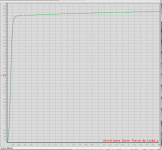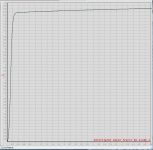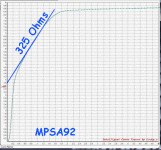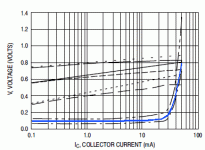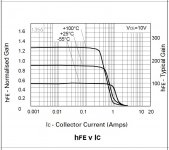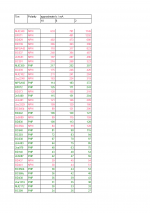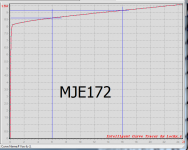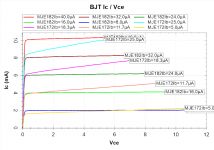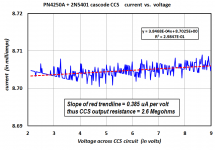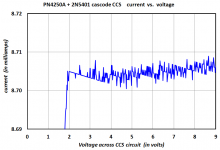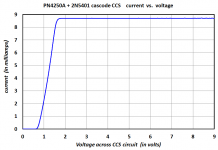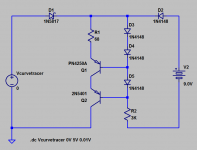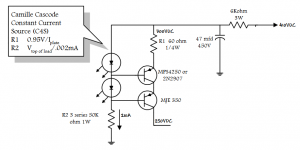More plots of knee voltage.
_
_
Attachments
-
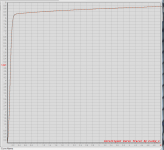 KSA1220AY_Knee.PNG78.8 KB · Views: 408
KSA1220AY_Knee.PNG78.8 KB · Views: 408 -
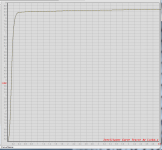 ZTX757_Knee.PNG80.4 KB · Views: 90
ZTX757_Knee.PNG80.4 KB · Views: 90 -
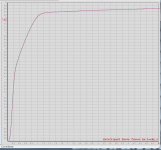 ZTX558_Knee.PNG77.2 KB · Views: 110
ZTX558_Knee.PNG77.2 KB · Views: 110 -
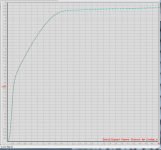 MPSA92_Knee.PNG81.5 KB · Views: 101
MPSA92_Knee.PNG81.5 KB · Views: 101 -
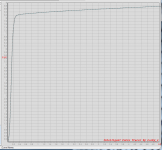 MPS8599_Knee.PNG76 KB · Views: 98
MPS8599_Knee.PNG76 KB · Views: 98 -
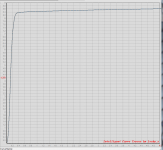 MJE350_ONS_Knee.PNG72.6 KB · Views: 94
MJE350_ONS_Knee.PNG72.6 KB · Views: 94 -
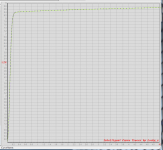 MJE253_Knee.PNG87.7 KB · Views: 388
MJE253_Knee.PNG87.7 KB · Views: 388 -
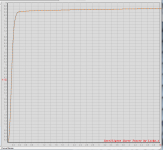 MJD350_ONS_Knee.PNG73.2 KB · Views: 382
MJD350_ONS_Knee.PNG73.2 KB · Views: 382 -
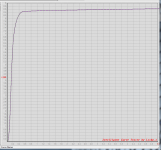 MJD350_FSC_Knee.PNG86.1 KB · Views: 393
MJD350_FSC_Knee.PNG86.1 KB · Views: 393 -
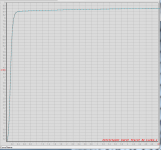 MJD350_DI_Knee.PNG78.4 KB · Views: 396
MJD350_DI_Knee.PNG78.4 KB · Views: 396
Because I read off the (I, V) datapoints by eyeball...
OK, thanks for the clarification, I just wanted to have some idea of the accuracy and resolution of the data.
Your top rated transistor has a difference in Ice of only 0.15 mA, so that's only 3 of your 0.05 mA steps, and I worried about the quantization.
Even round off to the nearest step makes the result vary by 25% or more.
But eyeballs tend to do a pretty decent job of best-fit... subject to "Pearl" restrictions
Best wishes
David
So this is the fabled quasi-saturation. A bit of a warning sign for those using 2SC2240/2SA970 and the like as general purpose transistors at lowish voltages.
That reminds me of this curious story here, where a very low-voltage circuit would only operate properly with 2N5087s but not BC860Cs and no-one could really tell why:
http://www.diyaudio.com/forums/analog-line-level/173069-low-noise-transistors-electret-mic.html
Now BC560C/860C are not exactly transistors I'd suspect of having high knee voltage, but maybe 2N5087 (being only 30V parts) have an extra-low one or something?
That reminds me of this curious story here, where a very low-voltage circuit would only operate properly with 2N5087s but not BC860Cs and no-one could really tell why:
http://www.diyaudio.com/forums/analog-line-level/173069-low-noise-transistors-electret-mic.html
Now BC560C/860C are not exactly transistors I'd suspect of having high knee voltage, but maybe 2N5087 (being only 30V parts) have an extra-low one or something?
The knee plots attached to post #1 show that the 800mA rated BC337, has a lower knee than the 100mA rated BC560. Since the 2N5087 is rated for only 50mA, it might have an even higher knee than the BC560.
All five of the lowest-knee-voltage-of-all transistors (knee = 0.3V) in the table in post #60, happen to also be very high current devices, ranging from 0.8A to 4.0A. Is that a necessary condition for ultra low knee voltage? Maybe.
Take a quick look at the knee of this stupendous NPN device, which is rated for 4 amperes: link to #7222. Is that a sweet, sweet device, or WHAT ?
All five of the lowest-knee-voltage-of-all transistors (knee = 0.3V) in the table in post #60, happen to also be very high current devices, ranging from 0.8A to 4.0A. Is that a necessary condition for ultra low knee voltage? Maybe.
Take a quick look at the knee of this stupendous NPN device, which is rated for 4 amperes: link to #7222. Is that a sweet, sweet device, or WHAT ?
> very high current devices, ranging from 0.8A to 4.0A. Is that a necessary condition for ultra low knee voltage? Maybe.
Well, MPSA92's "soft knee" looks an awful lot like a 325 Ohm resistor. See attached image.
And you can't sell a "1A" part if it has 300 Ohms inside. Probably has to be under 1r for a 1A part.
I'm skimming AS Grove for clues. I'm not sure if this is really 300r bending, or if it may be a base-resistance reflecting through.
Further tid-bit: MPSA is a High-Voltage part. That may lead to high resistance in the C-B area.
Also the ON Semi sheet shows severe fall-off or rise of hfe or Vce for currents over ~~30mA-- this is far from a high-current part. However their sketch of Vbe deviates a lot from what you actually measure, because they are forcing the Base current far past the "linear" range you explore.
Well, MPSA92's "soft knee" looks an awful lot like a 325 Ohm resistor. See attached image.
And you can't sell a "1A" part if it has 300 Ohms inside. Probably has to be under 1r for a 1A part.
I'm skimming AS Grove for clues. I'm not sure if this is really 300r bending, or if it may be a base-resistance reflecting through.
Further tid-bit: MPSA is a High-Voltage part. That may lead to high resistance in the C-B area.
Also the ON Semi sheet shows severe fall-off or rise of hfe or Vce for currents over ~~30mA-- this is far from a high-current part. However their sketch of Vbe deviates a lot from what you actually measure, because they are forcing the Base current far past the "linear" range you explore.
Attachments
Yes the ZTX958 (tied for "best", i.e., lowest Vknee) is also a high voltage device. RatedV = 400 volts, MeasuredBeta = 167, RatedCollectorCurrent = 1.5 amperes. The ZTX958's Beta vs Collector Current plot does not begin to defecate the bedsheets until collector current > 400 milliamps at room temperature (figure below). In my opinion the weaknesses and imperfections of the MPSA92 transistor are not shared by all of its high voltage brothers.
Attachments
Wow, our measurements on the MJE172 transistor are very far apart. You got 30 volts and I got 150 volts! The device I measured was made by ON Semiconductor and purchased from an authorized distributor. Here's the plot, attached.
Maybe this means: If you need big Early voltage for a certain device in your design, measure the actual part and verify its Vearly before soldering it down. Undesirable for mass production, perfectly fine for DIY. It just adds more hobby hours to the build and, by definition, hours spent on a hobby are enjoyable hours.
_
Maybe this means: If you need big Early voltage for a certain device in your design, measure the actual part and verify its Vearly before soldering it down. Undesirable for mass production, perfectly fine for DIY. It just adds more hobby hours to the build and, by definition, hours spent on a hobby are enjoyable hours.
_
Attachments
Last edited:
MJE172/182 traces
These are my traces of the MJE172 together with MJE182.
As you can see, these are very different indeed. I know that NPNs usually are (much) better than PNPs, but in this case the differens is vast.
Both are labelled as ON semi, but the "style" is different.
These are my traces of the MJE172 together with MJE182.
As you can see, these are very different indeed. I know that NPNs usually are (much) better than PNPs, but in this case the differens is vast.
Both are labelled as ON semi, but the "style" is different.
Attachments
I decided to build up the cascode PNP current source from post #34, and run it through the curve tracer to see how flat the current vs. voltage behavior actually is.
As shown in the attached schematic, I'm running the bias chain (D1-D3 + R2) from a separate 9V battery, so the bias current is neither supplied nor measured by the curve tracer. Diodes D4 and D5 are paranoia / safety devices which try to prevent the battery from harming the curve tracer and vice versa. Notice that paranoia diode D4 will increase the apparent "dropout" voltage of the constant current source (but not the flatness). So I used a high current Schottky in that position, to keep the deltaV below 300 mV.
The I-V curve is shown in Figure 2 below. It's pretty flat, and the thing operates as a very nice current source at any voltage greater than 1.8 volts. I'm pleased!
Figure 3 shows a zoom-in of the flat portion; you can see that my curve tracer is not the world's most precise measuring instrument. Still, what the hell, let's try to estimate the slope (output resistance) anyway. That's in Figure 4. I asked Excel to fit a linear trendline to the data and got the dotted red line, whose equation is in the box. Excel thinks the current source's output resistance is 2.6 Megohms. This is similar, but not identical, to the LTSPICE simulated value of output resistance in post #34. I'm pleased!
I've attached a zipped archive of the Excel data if anyone wants to mess around with it.
_
As shown in the attached schematic, I'm running the bias chain (D1-D3 + R2) from a separate 9V battery, so the bias current is neither supplied nor measured by the curve tracer. Diodes D4 and D5 are paranoia / safety devices which try to prevent the battery from harming the curve tracer and vice versa. Notice that paranoia diode D4 will increase the apparent "dropout" voltage of the constant current source (but not the flatness). So I used a high current Schottky in that position, to keep the deltaV below 300 mV.
The I-V curve is shown in Figure 2 below. It's pretty flat, and the thing operates as a very nice current source at any voltage greater than 1.8 volts. I'm pleased!
Figure 3 shows a zoom-in of the flat portion; you can see that my curve tracer is not the world's most precise measuring instrument. Still, what the hell, let's try to estimate the slope (output resistance) anyway. That's in Figure 4. I asked Excel to fit a linear trendline to the data and got the dotted red line, whose equation is in the box. Excel thinks the current source's output resistance is 2.6 Megohms. This is similar, but not identical, to the LTSPICE simulated value of output resistance in post #34. I'm pleased!
I've attached a zipped archive of the Excel data if anyone wants to mess around with it.
_
Attachments
Whoops, I forgot to compute the effective Early voltage which would give that same slope. Here we go:That's about 1.5x bigger than the product of the measured VAs of the two individual transistors: PN4250A_VA = 52, 2N5401_VA = 284. So the degeneration from emitter resistor R1 is helping a bit too. But remember that I measured VA at VCE=11 volts (midway between 6V and 16V), whereas this CCS circuit design runs the transistors at VCE=0.7 volts. Which is less.
- 8.7mA / (VA + 4.0V) = 3.85e-4 mA/volt
- VA = Early Voltage = 22593 volts
Not exactly; he was working with valves and hundreds of volts, so he used two LEDs to bias the PNP bases. I can't afford to lose that much headroom so I'm using three silicon diodes. My innermost transistor operates at VCE=0.65 volts (!). C4S runs its innermost transistor at VCE=1.70 volts.C4S CCS variation from John Camille?
_
Attachments
hoe
This thread brought back memories. We tried to build a PNP silicon transistor to match the germaniums that a certain car radio vendor had been using. They wanted to replace the germaniums with silicon without circuit changes. We managed it by using essentially using a 2n3906 mask with a 2n5401 process. The hoe of this device was ruler flat with the processes we used in those days.
Good times.
This thread brought back memories. We tried to build a PNP silicon transistor to match the germaniums that a certain car radio vendor had been using. They wanted to replace the germaniums with silicon without circuit changes. We managed it by using essentially using a 2n3906 mask with a 2n5401 process. The hoe of this device was ruler flat with the processes we used in those days.
Good times.
Cordell's VAF values for the BC560C/550C have matched my results with Kmultipliers and similar circuits when I used Fairchild transistors. On the other hand I discovered the BC337-40/327-40 from OnSemi were better in that application. After seeing how far parameters can change between manufacturers, I really see no point is making measurements without writing down at least the source company as well. This has caused me many headaches when trying to use someone's measurements to make a model.
You have the 2SA1859A, why not it's complement, the 2SC4883A?
astx provided a lot of data for different transistors here that I've been using to make models:
http://www.diyaudio.com/forums/soli...b-power-amp-200w8r-400w4r-30.html#post4643225
In many cases the Vaf isn't as low as what you are measuring.
You have the 2SA1859A, why not it's complement, the 2SC4883A?
astx provided a lot of data for different transistors here that I've been using to make models:
http://www.diyaudio.com/forums/soli...b-power-amp-200w8r-400w4r-30.html#post4643225
In many cases the Vaf isn't as low as what you are measuring.
Last edited:
See column "B" in the final table (attachment to post #47), the tippity-top of which I copied below.After seeing how far parameters can change between manufacturers, I really see no point is making measurements without writing down at least the source company as well.
Because it's not a PNP transistor. The whole list (and this whole thread) is PNP only.You have the 2SA1859A, why not it's complement, the 2SC4883A?
Some of the first couple dozen posts in this thread commented upon the futility of measuring and tabulating a device characteristic that is unspecified on the datasheet and uncontrolled in the fab. It's going to vary a lot, and the variations are going to be unpredictable, they said. Perhaps they are right.In many cases the Vaf [measured by member astx] isn't as low as what you are measuring.
To assist others who may wish to make comparisons between my measurements and their own, I've been attaching the I-V curves straight from my curve tracer. Then extracting the Early Voltage "VA" is a simple matter of solving a linear equation
- Ice @ 16V = (VA + 16V) * (slope of I-V curve @ 16V)
Let me know if there are any I-V curves missing from this PNP thread, that you'd like to see. They're not proprietary trade secrets after all.
_
Attachments
Certainly, you cannot take transistors from different manufacturers and expect the Vaf to be similar. Ditto for different Hfe grades. I think the meaningful question here is, if I use the same transistor from the same manufacturer, over time what amount of variation of Early voltage will I get from new parts? I think it won't be outrageously bad, otherwise we would have given up trying to choose better transistors. So how bad is it in reality? Comparisons between different transistors and manufacturers are of uncertain utility until this question is answered.
Feel free to tackle that question if you want to.
Truthfully the question is not relevant to my own personal situation because my DIY projects are single unit custom builds; I don't need or want to fabricate a hundred or a thousand copies. I also don't mind testing and individually selecting parts for my single unit custom build. Buy twenty parts, test them all, and use the best two in my DIY project. Put away the others in a drawer, for another day perhaps.
In fact the numbers are even larger because I buy from (in)famous distributor Rochester Electronics, who has a $100 minimum line-item. On TO-92 transistors priced at $0.03 per piece, that means I'm ordering qty=3334 just to bring the line item amount up to $100. So I am swimming in these little babies and I can cherry-pick the very best of the best (say, the top 2%) if I so choose. I don't need or want transistors whose Early Voltage is constant from lot to lot and year to year; I just want a population of transistors whose top few percent have excellent Early voltage. Not such a great approach for high volume manufacturing, I admit. But then I'm not trying to compete with Samsung either.
Truthfully the question is not relevant to my own personal situation because my DIY projects are single unit custom builds; I don't need or want to fabricate a hundred or a thousand copies. I also don't mind testing and individually selecting parts for my single unit custom build. Buy twenty parts, test them all, and use the best two in my DIY project. Put away the others in a drawer, for another day perhaps.
In fact the numbers are even larger because I buy from (in)famous distributor Rochester Electronics, who has a $100 minimum line-item. On TO-92 transistors priced at $0.03 per piece, that means I'm ordering qty=3334 just to bring the line item amount up to $100. So I am swimming in these little babies and I can cherry-pick the very best of the best (say, the top 2%) if I so choose. I don't need or want transistors whose Early Voltage is constant from lot to lot and year to year; I just want a population of transistors whose top few percent have excellent Early voltage. Not such a great approach for high volume manufacturing, I admit. But then I'm not trying to compete with Samsung either.
- Home
- Amplifiers
- Solid State
- Measuring the Early voltage "VA" of some PNPs at 8mA
